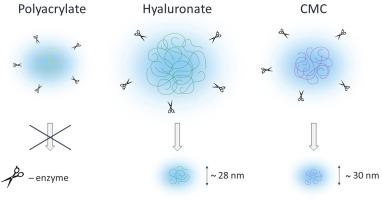Enzyme-induced degradation of natural and artificial linear polyanions
IF 2.4
3区 化学
Q3 BIOCHEMISTRY & MOLECULAR BIOLOGY
引用次数: 0
Abstract
Synthetic and natural polymers are widely used for constructing drug delivery systems. Biocompatibility, water solubility and non-toxicity make polymers a convenient matrix for encapsulation, delivery and release of bioactive compounds. Coupling of a drug with a biodegraded polymer matrix is a promising way for a controlled drug delivery. Along this line, the degradation of the four polymers in the presence of two enzymes in aqueous solutions was investigated. The following polymers were used: natural polysaccharides, sodium alginate and sodium hyaluronate, artificial (modified) sodium carboxymethylcellulose and synthetic sodium polyacrylate (control); their degradation was caused by the addition of alginate lyase and hyaluronidase. The first enzyme only cleaved the specific alginate substrate and left three other intact. Contrastingly, the second enzyme degraded all three polysaccharides, including artificial carboxymethylcellulose, but did not degrade synthetic polyacrylate. The biodegradation of polymers was accompanied by decreasing the size of polymer particles in solution from 100 to 200 nm down to 20–30 nm; the latter are capable of removing from the body through the kidneys. The initial polysaccharides showed the negative surface charge in aqueous solution, which changed but retained negative after biodegradation. The initial and biodegraded polysaccharides demonstrated negligible cytotoxicity during long exposure period. The obtained results are valuable for the development of polymer carriers for drug encapsulation and delivery.

天然和人工线性聚阴离子的酶诱导降解。
合成聚合物和天然聚合物被广泛用于构建给药系统。生物相容性、水溶性和无毒性使聚合物成为封装、输送和释放生物活性化合物的便捷基质。将药物与生物降解聚合物基质结合起来,是一种很有前景的可控给药方法。沿着这一思路,我们研究了四种聚合物在水溶液中两种酶存在下的降解情况。使用了以下聚合物:天然多糖、海藻酸钠和透明质酸钠、人工(改性)羧甲基纤维素钠和合成聚丙烯酸钠(对照组);添加海藻酸裂解酶和透明质酸酶可导致它们降解。第一种酶只裂解特定的藻酸盐底物,而使其他三种底物完好无损。相反,第二种酶降解了所有三种多糖,包括人工羧甲基纤维素,但没有降解合成聚丙烯酸酯。在聚合物发生生物降解的同时,溶液中聚合物颗粒的大小也从 100 至 200 纳米减小到 20 至 30 纳米;后者能够通过肾脏排出体外。最初的多糖在水溶液中呈现负表面电荷,生物降解后表面电荷发生变化,但仍为负电荷。初始多糖和生物降解后的多糖在长期接触过程中的细胞毒性可忽略不计。这些结果对开发用于药物封装和递送的聚合物载体具有重要价值。
本文章由计算机程序翻译,如有差异,请以英文原文为准。
求助全文
约1分钟内获得全文
求助全文
来源期刊

Carbohydrate Research
化学-生化与分子生物学
CiteScore
5.00
自引率
3.20%
发文量
183
审稿时长
3.6 weeks
期刊介绍:
Carbohydrate Research publishes reports of original research in the following areas of carbohydrate science: action of enzymes, analytical chemistry, biochemistry (biosynthesis, degradation, structural and functional biochemistry, conformation, molecular recognition, enzyme mechanisms, carbohydrate-processing enzymes, including glycosidases and glycosyltransferases), chemical synthesis, isolation of natural products, physicochemical studies, reactions and their mechanisms, the study of structures and stereochemistry, and technological aspects.
Papers on polysaccharides should have a "molecular" component; that is a paper on new or modified polysaccharides should include structural information and characterization in addition to the usual studies of rheological properties and the like. A paper on a new, naturally occurring polysaccharide should include structural information, defining monosaccharide components and linkage sequence.
Papers devoted wholly or partly to X-ray crystallographic studies, or to computational aspects (molecular mechanics or molecular orbital calculations, simulations via molecular dynamics), will be considered if they meet certain criteria. For computational papers the requirements are that the methods used be specified in sufficient detail to permit replication of the results, and that the conclusions be shown to have relevance to experimental observations - the authors'' own data or data from the literature. Specific directions for the presentation of X-ray data are given below under Results and "discussion".
 求助内容:
求助内容: 应助结果提醒方式:
应助结果提醒方式:


